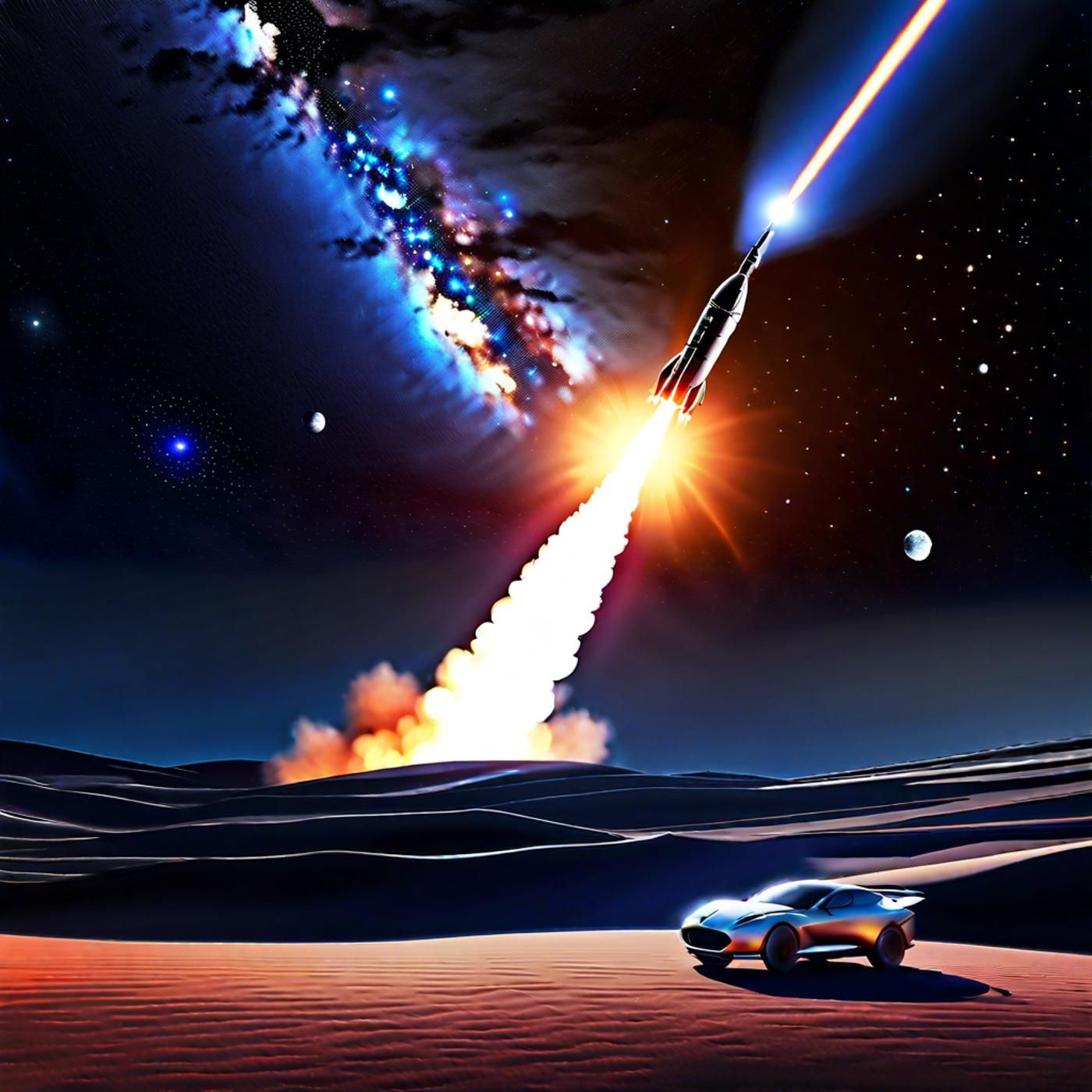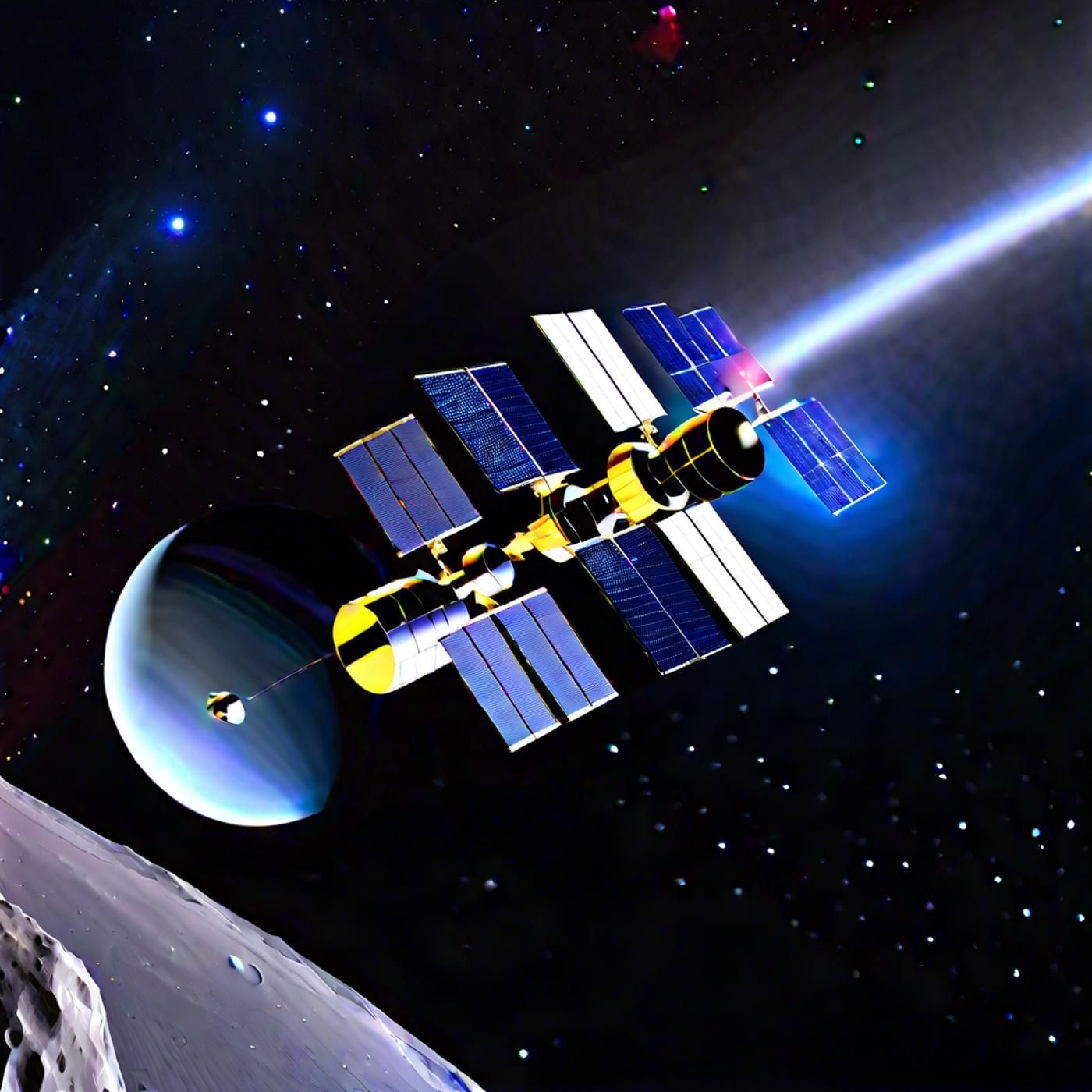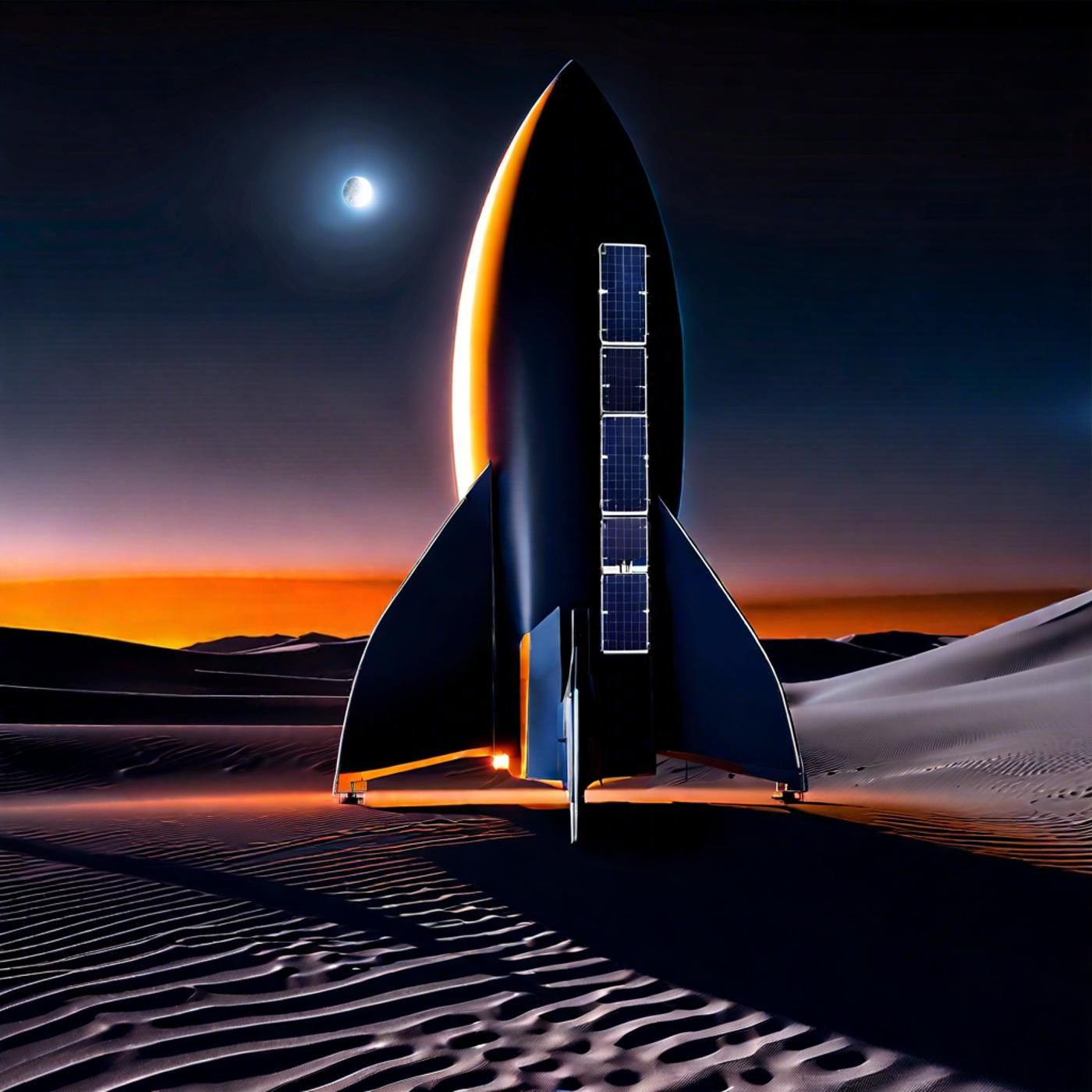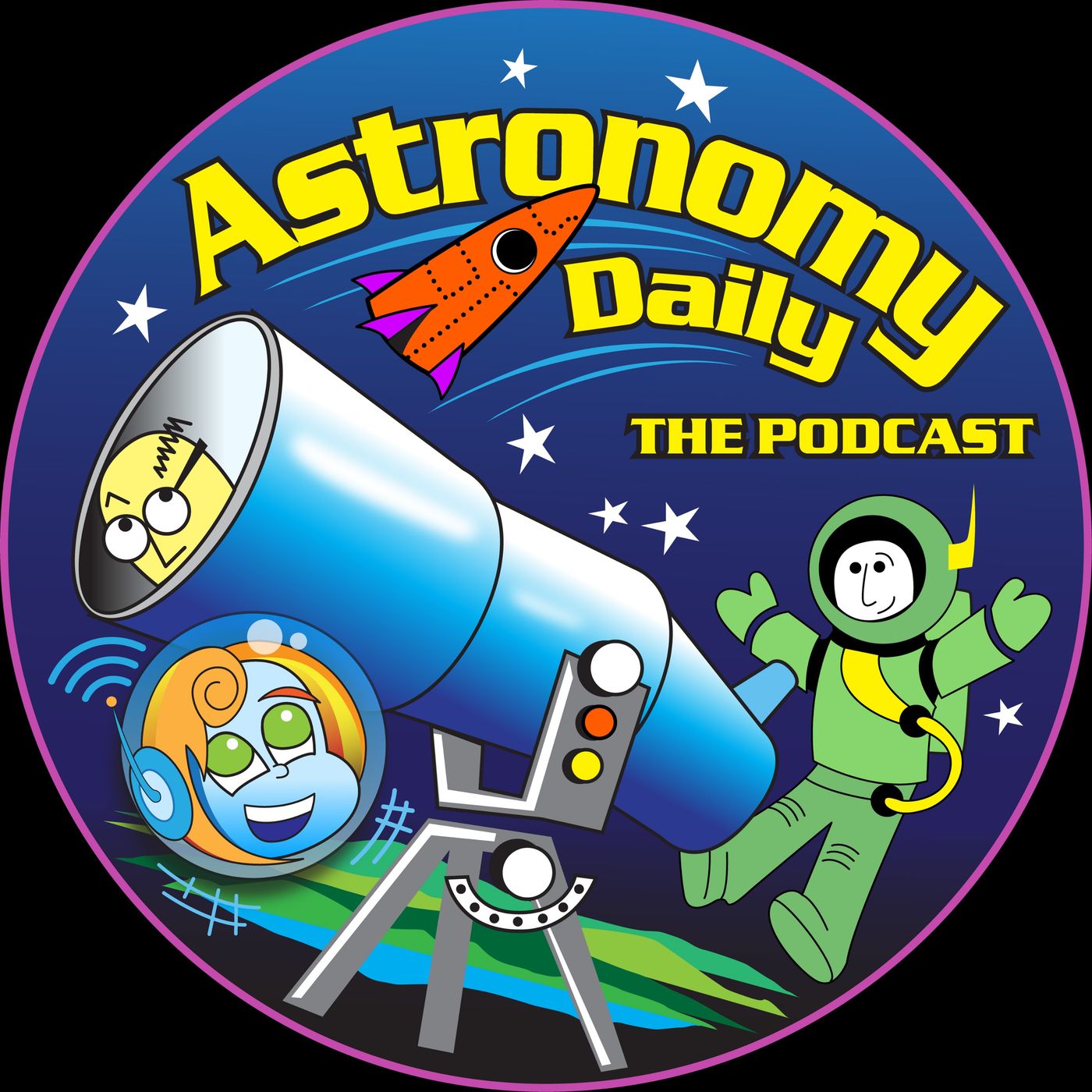S03E72: Martian Frost Mysteries & Starliner's Critical Tests

Embark on a celestial journey with today's episode of Astronomy Daily - The Podcast, where your host, Anna, guides you through the latest cosmic updates. We'll start with the remarkable discovery of early morning frost on the peaks of Mars' giant...
Embark on a celestial journey with today's episode of Astronomy Daily - The Podcast, where your host, Anna, guides you through the latest cosmic updates. We'll start with the remarkable discovery of early morning frost on the peaks of Mars' giant dormant volcanoes, captured by the European Space Agency's Trace Gas Orbiter. This finding could have a profound impact on our understanding of water distribution on the red planet and its implications for future human exploration. Next, we'll turn our attention to the International Space Station, where NASA and Boeing are making significant strides with the Starliner spacecraft. We'll cover the latest tests and what they mean for the future of crewed missions. We'll also explore the stunning observations made during a recent major solar storm that illuminated Mars, offering critical data on the radiation future astronauts might face. Additionally, the James Webb Space Telescope has captured a massive asteroid collision in the Beta Pictoris star system, shedding light on the chaotic process of planet formation. Finally, we'll discuss the cutting-edge development of direct-to-cell satellite technology, which has the potential to revolutionize military communications and enhance global connectivity. Stay with us for an exciting journey through the cosmos.For an astronomical experience, visit our website at astronomydaily.io for the latest news, sign up for our free newsletter, and check out exclusive sponsor deals. Connect with us on YouTube, TikTok, X, and Facebook via @AstroDailyPod for engaging discussions with fellow space aficionados. This is Anna, reminding you to keep your gaze fixed on the heavens. Until our next stellar episode, let the cosmos ignite your curiosity and wonder. Clear skies and cosmic discoveries to all!
Support:
This podcast is better with your support:
https://www.bitesz.com/show/astronomy-daily-the-podcast/support/
www.bitesz.com
Sponsors:
www.bitesz.com/nordpass
https://www.bitesz.com/show/astronomy-daily-the-podcast/sponsors/
Today's Space and Astronomy News from around the web and beyond.
Transcript
Welcome to Astronomy Daily, the podcast that brings you the latest and greatest news from the cosmos. I'm your host, Anna, and I’m thrilled to have you with me today. In today's episode, we have some truly fascinating stories lined up for you. First, we will dive into the remarkable discovery of early morning frost on the peaks of Mars's giant, dormant volcanoes. This finding, captured by the European Space Agency’s Trace Gas Orbiter, could have a profound impact on our understanding of water distribution on the Red Planet and its implications for future human exploration. Next, we'll turn our attention to the International Space Station, where NASA and Boeing are making significant strides with the Starliner spacecraft. We'll cover the latest tests and what they mean for the future of crewed missions.
We'll also explore the stunning observations made during a recent major solar storm that illuminated Mars, offering critical data on the radiation future astronauts might face. And, if that wasn’t enough, the James Webb Space Telescope has captured a massive asteroid collision in the Beta Pictoris star system, shedding light on the chaotic process of planet formation. Finally, we'll discuss the cutting-edge development of direct-to-cell satellite technology, which has the potential to revolutionize military communications and enhance global connectivity. So, sit back, relax, and let’s embark on this cosmic journey together!
The Astronomy Daily Podcast.
Today, we have some thrilling news from Mars that challenges our existing understanding and offers new possibilities for the future of space exploration. Scientists have made an unexpected discovery: early morning frost on the peaks of some of Mars' most massive and extinct volcanoes. This discovery was made possible by the European Space Agency’s Trace Gas Orbiter, which has been orbiting the Red Planet since 2018. Mars is home to some colossal volcanoes, with the most famous being Olympus Mons, which stands almost three times taller than Mount Everest. These behemoths are located in the Tharsis plateau, a vast elevated region near the Martian equator. Interestingly, these volcanoes have been dormant for millions of years, and until now, no one expected to find frost near the planet’s equator. Leed study author Adomas Valantinas was among the first to react, mentioning the surprise of the scientific community. The prevailing belief was that frost formation around the Martian equator was impossible due to the sunshine and thin atmosphere, which keeps temperatures relatively warm compared to what we experience on Earth. Adding to the mystery is the fact that there is very little water vapor in the atmosphere near Mars’ equator, making condensation seem highly improbable.
The discovery came about somewhat by chance. The Trace Gas Orbiter was able to capture images just as the first rays of the Sun began to cross the volcano peaks, revealing shiny, blue deposits that were visible only in the early morning and during the cold seasons. According to the researchers, this layer of frost is incredibly thin, no thicker than a human hair, and it doesn't last long. Yet, it consists of about 150,000 tonnes of water, equating to nearly 60 Olympic swimming pools! The implications of this discovery are immense. Researchers suggest that this frost forms due to a micro-climate within the calderas of the volcanoes. As the wind moves up the sides of these massive structures, it carries relatively moist air from the surface to higher altitudes, where it then condenses and settles as frost. This phenomenon mirrors processes we observe here on Earth and in other parts of Mars, offering new avenues for scientific modeling.
Understanding how these frosts form can provide scientists with more clues about the remaining secrets of Mars, including the vital distribution networks of water. This is essential because water, in any form, is considered a crucial ingredient for life. By mapping where water exists and how it moves between various reservoirs, scientists can better plan for human exploration missions. Potentially, future Mars missions could utilize this frost as a water source for human consumption or even to launch rockets by separating the hydrogen and oxygen molecules within the frost. Moreover, these findings could also be pivotal in the ongoing search for extraterrestrial life. Since liquid water is a key ingredient for life as we understand it, knowing where and how water accumulates on Mars allows for more targeted exploration and greater chances of finding signs of past or present life.
This discovery not only reshapes our understanding of Martian geology and climate but also underscores the importance of continued robotic exploration. Each piece of new information we gather helps to build a more detailed picture of Mars, ultimately bringing us one step closer to sending humans to the Red Planet. So, as we marvel at the frost on these giant Martian volcanoes, let’s also keep an eye on how this new understanding will guide future missions and maybe one day, human settlers on Mars. The Martian landscape continues to be a treasure trove of surprises, and with each discovery, we edge closer to making permanent footsteps on this enigmatic planet. Stay tuned for more fascinating insights into our solar system!
Thank you for watching!
Today, let's talk about Boeing's Starliner spacecraft and its critical tests currently underway at the International Space Station. This mission represents a significant step in NASA's Commercial Crew Program, aimed at certifying the Starliner for regular crewed missions to the station. Since arriving at the ISS on June 6, NASA astronauts Butch Wilmore and Suni Williams have undertaken a series of rigorous tests. These include putting the spacecraft in minimal power mode to assess its energy efficiency for operational missions. They've conducted "safe haven" checks to ensure Starliner can support astronauts in an emergency, offering its own air and consumables if the situation demands. But that's not all. A habitability study is also in progress, led by astronauts Tracy Dyson and Matthew Dominick. This study evaluates seating positions and air circulation within the spacecraft, ensuring that it remains comfortable and functional for a four-person crew. Additionally, the team is scrutinizing the fit of spacesuits and seats, and checking the service module's batteries to guarantee reliable performance.
Ground teams are closely monitoring Starliner's condition and gathering data to confirm its readiness for its return trip, planned for June 18. According to NASA's Commercial Crew Program Manager, Steve Stich, "We expected to do a lot of valuable learning on this test flight, and I am extremely proud of how the NASA and Boeing teams are working together to ensure we can safely execute the return portion of the mission." Despite a few minor issues—like a reaction control system thruster being de-selected and minor leaks in the service module's helium manifolds—the spacecraft has sufficient margin to support its return journey. The exciting part of the mission will come when Starliner undocks from the ISS, adjusts its orbit, performs a deorbit burn, reenters Earth's atmosphere, and finally lands in the southwestern United States using parachutes and airbags. This phase marks the final crucial steps before the spacecraft can be certified for regular missions.
Meanwhile, activities at the ISS continue unabated. The Expedition 71 crew is preparing for an upcoming spacewalk to conduct science and maintenance tasks. They plan to retrieve faulty communications hardware and swab station surfaces for microorganisms, ensuring the station remains operational and safe. NASA Flight Engineers Tracy C. Dyson and Matthew Dominick are key players in these preparations, working alongside their colleagues to ensure everything goes smoothly. Additionally, health checks, computer maintenance, and installation of space fire investigation hardware are part of the astronauts' daily tasks. In the Roscosmos segment, activities like water transfer from the Progress 88 resupply ship and vent cleaning are underway, showcasing the constant diligence required to keep the ISS running optimally. Through this mission, NASA and Boeing aim to take crewed spaceflight to new heights, literally and figuratively. By rigorously testing Starliner, they are ensuring that future astronauts have a reliable, safe, and efficient vessel for their journeys to and from space. As ground teams continue to collect and analyze data, each step brings us closer to regular, sustainable crewed missions, expanding our capabilities in space exploration.
Stay tuned for more updates on this groundbreaking mission and what it means for the future of human spaceflight.
Thank you for watching!
On Mars, scientists have been anticipating significant solar storms as the Sun entered a period of peak activity called solar maximum. Over the past month, NASA's Mars rovers and orbiters have come through in a big way, providing researchers with direct observations of solar flares and coronal mass ejections that have hit the Red Planet, even causing Martian auroras. This series of events has offered a unique window into how these phenomena unfold in deep space and has given us a clearer picture of the radiation that future astronauts on Mars might encounter. The largest event took place on May 20. The Solar Orbiter spacecraft data estimated the solar flare at a magnitude of X12. This powerful flare emitted an intense burst of X-rays and gamma rays toward Mars. Following that, a coronal mass ejection sent charged particles hurling through space. The X-rays and gamma rays arrived first, as they travel at the speed of light, while the charged particles reached Mars in just a matter of tens of minutes. Analysts at the Moon to Mars Space Weather Analysis Office at NASA's Goddard Space Flight Center meticulously tracked this event, flagging the imminent arrival of these energetic particles.
Now, here’s the astounding part: had astronauts been standing right next to NASA's Curiosity Mars rover during this storm, their radiation exposure would have been equivalent to 30 chest X-rays—8,100 micrograys to be precise. While not immediately fatal, this is the largest surge ever measured by Curiosity’s Radiation Assessment Detector (RAD) since its landing 12 years ago. This crucial data is vital for planning future missions to Mars, helping scientists to anticipate and mitigate the highest levels of radiation exposure astronauts might face. To protect themselves, future astronauts could use the Martian landscape, such as cliffsides or lava tubes, as natural shields against such events. And it’s not just the surface crew that needs shielding; in Mars orbit or deep space, the dose rate would be significantly higher. The principal investigator for RAD, Don Hassler of Southwest Research Institute, even speculated that this active region on the Sun could continue to erupt, suggesting more solar storms might be on the horizon for both Earth and Mars.
During the May 20 event, the energy released was so massive that Curiosity’s navigation cameras showed what looked like “snow”—white streaks and specks caused by charged particles hitting the cameras. Likewise, NASA's 2001 Mars Odyssey orbiter’s star camera faced an overload of energy from solar particles, temporarily deactivating, although the orbiter quickly recovered and continued to collect essential data on X-rays and gamma rays. High above the surface, NASA's MAVEN orbiter captured another treat for astronomers: glowing auroras over the entire planet. Unlike on Earth, where auroras are usually confined to polar regions due to our strong magnetic field, Mars’ lack of a global magnetic field means these charged particles create auroras that can blanket the entire planet. MAVEN’s Solar Energetic Particle instrument played a key role in understanding this process, providing a timeline of the particles’ journey and interactions with Mars’ atmosphere.
Christina Lee, MAVEN Space Weather Lead at the University of California, Berkeley, remarked that this was "the largest solar energetic particle event that MAVEN has ever seen," and there have been several waves of such particles recently. NASA’s scientific fleet continues to gather data which will not only help future Mars missions but also contribute to the broader field of heliophysics. Upcoming missions like ESCAPADE, scheduled for late 2024, will provide even more detailed observations. By using twin small satellites in orbit around Mars, ESCAPADE will offer an enhanced dual perspective of space weather events, building on the invaluable knowledge we’ve already gained. These observations are critical in preparing for the challenges that lie ahead as humanity edges closer to setting foot on Mars. Understanding the Martian environment and the powerful forces of our Sun is essential for ensuring astronauts’ safety and mission success. So, while the Sun may be stormy, it's shedding light on Mars like never before!
Thank you for watching!
Beta Pictoris has always been a captivating star system for astronomers, and now, with the aid of the James Webb Space Telescope, we’re gaining unprecedented insights into its dynamic processes. Recently, Webb captured what appears to be a colossal collision of asteroids within this neighboring star system. This discovery is shedding light on the turbulent environments where planets are born. The collision, which involved giant asteroids, gives us a peek into the early stages of planetary formation—a time marked by chaotic and violent impacts. Webb’s observations are particularly revealing because they provide a real-time look at the forces that shape star systems, processes that our own Solar System went through billions of years ago. Leading the research is Christine Chen, an astronomer at Johns Hopkins University. She explains that Beta Pictoris is still young, at around 20 million years old, compared to our Solar System’s 4.5 billion years. At such a formative age, it's not uncommon for giant asteroids to collide, a chaotic dance that eventually leads to the formation of planets.
The team's findings were based on comparing new data from Webb with previous observations from the Spitzer Space Telescope dating back to 2004 and 2005. Spitzer had initially detected dust clouds, but when Webb analyzed the same region more recently, those dust signatures had vanished—a clear sign that something extraordinary had happened. Chen's team discovered that the dust, primarily composed of crystalline silicates similar to those found on Earth, once heated up by Beta Pictoris’ star, no longer displays the same signatures. This suggests a cataclysmic collision took place around two decades ago. The wreckage from this event has likely cooled and dispersed, becoming too faint to detect. Imagine this: the amount of dust generated was equivalent to 100,000 times the size of the asteroid that wiped out the dinosaurs on Earth. The debris from such a collision would be scattered far and wide by the star’s radiation, gradually fading from view. Webb's new data offers a snapshot of this process in action, fundamentally altering our understanding of Beta Pictoris.
Interestingly, the system is home to at least two known gas giants, Beta Pic b and c, which also interact with the surrounding dust and debris. These planets may have played roles in influencing or being influenced by these massive collisions. One fascinating aspect of this discovery is how it underscores the capabilities of the James Webb Space Telescope. Unlike many of its other groundbreaking discoveries, Webb’s contribution here comes from identifying what wasn't there—dust that had previously been a prominent feature in Spitzer's observations. This ability to detect subtle changes gives astronomers a powerful tool to decipher the early, chaotic histories of star systems. These findings not only enhance our understanding of Beta Pictoris but also offer broader implications for astronomy. As researchers continue to explore Webb’s data, they will gain more insight into the frequency and impact of such colossal collisions in young star systems. This will help answer fundamental questions about planet formation and the commonalities between different planetary systems.
So, in essence, what Webb's new observations reveal is a celestial drama playing out 63 light-years away. It's a drama that might very well resemble the early, transformative years of our own Solar System when it was young, volatile, and full of potential. Understanding these processes not only satisfies our curiosity about other star systems but also brings us one step closer to comprehending our own cosmic origins.
Thank you for watching!
In a surprising development that could revolutionize military communications, commercial satellite technology is enabling smartphones to connect directly to satellites. This innovation has caught the eye of the U.S. Space Force, which sees it as a potentially disruptive force for existing military satellite communication programs. Direct-to-cell satellite communication technology simplifies the process of connecting standard smartphones directly to satellites in orbit, bypassing traditional cell towers. Companies like Starlink, Iridium, Lynk Global, and AST SpaceMobile are leading the charge in making this technology viable. This breakthrough could transform how troops communicate, offering a more resilient and versatile alternative to current systems. Currently, the military relies on narrowband satellite communication systems like MUOS, the Mobile User Objective System. MUOS enables secure voice and data transmissions to mobile forces around the globe. However, direct-to-cell technology could outpace traditional systems in terms of adaptability and ease of use.
Col. Eric Felt, director of space architecture at the office of the assistant secretary of the Air Force for space acquisition and integration, expressed the significance of this development. He noted that the Space Force is actively tracking progress in commercial satellite communications, recognizing their potential to enhance or perhaps replace current military satcom systems. “We view direct-to-cell as a really disruptive thing,” Felt said. The Space Force is particularly interested in how this technology evolves because it could inform how they provide service to narrowband users in the future. A key advantage of direct-to-cell technology is its ability to provide basic connectivity, such as messaging, for regular smartphones—even in areas without traditional cell coverage. By routing phone signals through satellites, these services enable instant communication without the need for specialized equipment. This could substantially improve operational capabilities and offer a new layer of resilience for military communications.
However, the integration of this technology into military operations will require rigorous cybersecurity evaluations to ensure secure communications. Despite these challenges, the potential benefits—such as instantly connecting troops on any device without specialized hardware—make the Pentagon keen to explore direct-to-cell capabilities. The military's current plan involves extending the service life of the MUOS constellation, with two new satellites potentially being acquired from either Lockheed Martin or Boeing. This MUOS Service Life Extension program aims to sustain MUOS capabilities into the 20 thirties. Meanwhile, the Space Force is exploring how commercial direct-to-cell services could fit into future narrowband architecture. Clare Hopper, head of the Space Force’s Commercial Satellite Communications Office (CSCO), mentioned that some direct-to-cell satcom providers have been selected to bid for contracts under the Proliferated Low Earth Orbit satellite services program. This approach could be the most efficient way to secure these services on contract, she noted.
Iridium’s role in this evolving landscape is also significant. The company, which has a longstanding partnership with the military, is developing a new direct-to-cell service called Project Stardust. This service will enable standard smartphones to connect to Iridium’s low Earth orbit satellite network, enhancing the military’s communication capabilities further. Though Iridium's contract with the Department of Defense is up for renewal in 2026, there is potential for continuous collaboration. The future contracts might incorporate additional capabilities provided by direct-to-cell technology, auguring a new era of satellite communications. As these developments unfold, the U.S. Space Force remains committed to exploring the best possible solutions for secure, resilient military communications. Direct-to-cell satellite technology is just one example of how commercial innovations can potentially transform military operations and improve connectivity for troops in the field. This technological evolution underscores the importance of staying at the forefront of communication advancements to maintain strategic and operational superiority.
Thank you for tuning in to today's episode of Astronomy Daily. I hope you enjoyed our deep dive into the latest discoveries and ongoing missions that are shaping our understanding of the cosmos. For even more fascinating space news and updates, be sure to visit our website at astronomydaily.io. We cover everything from planetary science to the latest advancements in space technology. Also, stay connected with us on social media to ensure you never miss out on any astronomical breakthroughs. You can find us on YouTube, X, TikTok, and Facebook. Just search for Astronomy Daily Pod and join our growing community of space enthusiasts. Until next time, keep looking up and exploring the wonders of the universe. I'm Anna, and this has been Astronomy Daily.
New to Astronomy Daily - The Podcast?
Here are some great episodes to start with.




















